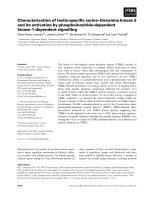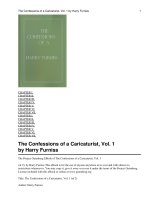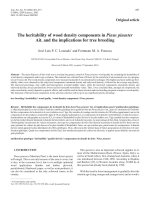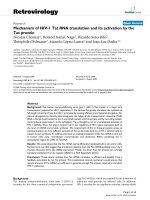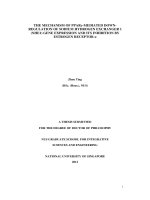THE MECHANISM OF PPARN3 MEDIATED DOWN REGULATION OF SODIUM HYDROGEN EXCHANGER 1 (NHE1) GENE EPXRESSION AND ITS INHIBITION BY ESTROGEN RECEPTOR n1 4
Bạn đang xem bản rút gọn của tài liệu. Xem và tải ngay bản đầy đủ của tài liệu tại đây (4.76 MB, 21 trang )
116
washed and reseeded at a density of 1.0 X 10
4
cells/100mm dish. After 14 days of
incubation, cells were stained with crystal violet. Graphical representation of
colony counts from colony forming assays. Results denote means +/-SD
computed from three experiments. *, p<0.05, treated versus untreated control.
3A4.4 Anti-tumor effect of 15d-PGJ
2
is partially ROS/RNS-dependent.
Evidence from literature has shown induction of ROS/RNS by various PPARγ
ligands in different cancer cells, which in turn is linked to mitochondrial damage
and subsequent cell death (Ichihara and Pelliniemi, 2007; Ito et al., 2007; Julie et
al., 2008; Wang and Mak, 2011). In previous sections, we also showed that
PPARγ ligands produced abundant ROS/RNS in breast cancr cells (Figure 9B),
and pre-incubation with FeTPPS completely scavenged the ROS/RNS detected by
DCFDA staining (Figure 10A).
As a next step in identifying the specific involvement of PPARγ ligand-induced
ROS in cell survival, FeTPPS was again used to decompose all ROS/RNS
generated by 15d-PGJ
2
. MCF-7 cells were incubated with FeTPPS for 2h prior to
exposure to 15d-PGJ
2
for 24h. Cell viability was then assessed using crystal violet
assay. As shown in figure 16A, the presence of FeTPPS although not completely,
but significantly rescued the cell viability loss initially induced by 5µM and
10µM of 15d-PGJ
2
(Figure 16A). Given the fact that the partial rescuing effect
was only observed at higher concentration of 15d-PGJ
2
, which induced a more
potent production of ROS/RNS (Figure 9C), we infer that 15d-PGJ
2
-mediated cell
viability loss is fractionally ROS/RNS dependent, especially at higher
concentration of the drug. Next we asked if FeTPPS could similarly rescue the
117
colonogenic ability of cells from 15d-PGJ
2
-induced inhibition. MCF-7 cells were
pre-incubated with FeTPPS for 2h, before they were challenged with 15d-PGJ
2
for 16h and then reseeded. The colony forming assay showed that the presence of
FeTPPS rescued approximately 20% out of 80% loss in colony-forming ability of
15d-PGJ
2
-treated MCF-7 cells (Figure 16B). Taken together, these results suggest
the involvement of peroxynitrite in 15d-PGJ
2
-induced inhibition on cell survival.
118
Figure 16: FeTPPS rescues the loss of cell viability and cologenic ability
induced by PPARγ ligand in breast cancer cells.
(A) MCF-7 (1.5X10
5
cells/12-well dishes) cells were exposed to 15d-PGJ
2
for
24h with or without 2h pre-incubation of 50µM FeTPPS. Crystal violet assay was
then used to determine cell viability as described in Materials and Methods.
119
Results denote means +/-SD computed from two experiments done in duplicate.
(B) MCF-7 (3 X10
5
cells/6-well dishes) cells were exposed to 15d-PGJ
2
for 16h
with or without 2h pre-incubation of 50µM FeTPPS. Following that, cells were
washed and reseeded at a density of 1.0 X 10
4
cells/100mm dish. After 14 days of
incubation, cells were stained with crystal violet. Graphical representation of
colony counts from colony forming assays. Results denote means +/-SD
computed from three experiments. *, p<0.05, **, p<0.01, treated versus untreated
control.
3A4.5 Reduced NHE1 expression is responsible for PPARγ-mediated anti-
tumor effects.
We have thus far demonstrated that PPARγ activation leads to down-regulation of
NHE1 expression, and PPARγ ligands significantly inhibited the short-term cell
viability and long-term colony forming ability in various breast cancer cells.
Previous study from our group also showed that the expression of NHE1 was
critical for tumour growth (Akram et al., 2006). Intrigued by the parallel
repression of NHE1 expression and tumor growth by PPARγ activation, we asked
if the anti-tumor effect of PPARγ is dependent on NHE1 down-regulation.
The first study that demonstrated the importance of NHE1 in cell proliferation
was by Pouyssegur and colleagues. They reported that fibroblasts lacking NHE1
activity showed markedly impaired growth in neutral and acidic pH compared to
NHE1-competent cells (Pouyssegur et al., 1984). To confirm the role of NHE1 in
breast cancer cell proliferation, we silenced the NHE1 gene in MDA-MB-231
cells using siRNA specific for NHE1 gene. The transfected cells were replated
onto 100mm dish and kept for 14 days, before the colonies formed were stained
120
with crystal violet. Corroborating with previous findings, colony forming assay
showed that cells transfected with NHE1 siRNA exhibited remarkably reduced
colonogenic ability (supplementary Figure 1A of published paper) (Kumar et al.,
2009).
After confirming the importance of NHE1 in colony forming ability of MCF-7
cells, we wanted to investigate if NHE1 is involved in the PPARγ ligand-induced
reduction in cell viability and colony forming ability. To this end, MDA-MB-231
cells, which express lower intrinsic level of NHE1, were co-transfected with a
construct encoding green fluorescent protein in addition to the vector encoding
functional NHE1 protein or the parent empty vector. Based on the assumption that
the transfection effieciency was similar for the fluorescent protein and NHE1
plasmid, we surmised that the green fluorescent cells represented cells transiently
overexpressing NHE1. The morphological changes were then studied under
fluorescent mircroscopy. It was observed that cells transfected with the empty
vector showed formation of vacuoles after treatment of 15d-PGJ
2
. On the other
hand, cells that over-expressed NHE1 still maintianed a viable morphology upon
exposure to15d-PGJ
2
(Figure 2B of published paper) (Kumar et al., 2009).
The long-term colony-forming ability of NHE1-overexpressing MDA-MB-231
cells was also assessed using colony forming assay. MDA-MB-231 cells were co-
transfected with plasmid encoding full length NHE1 gene or empty vector in
addition to a vector conferring hygromycin resistance. The transfected cells were
trypsinized and reseeded onto 100mm dish after 16h exposure to 15d-PGJ
2
. The
selection of NHE1-overexpressing cells was then achieved by including
121
hygromycin in the culturing medium for 14 days, before the colonies were stained
with crystal violet. As expected, in cells transfected with empty vector, 15d-PGJ
2
induced a significant reduction in the number of colonies formed (Figure 2A of
published paper) (Kumar et al., 2009). However, overexpression of NHE1 protein
in MDA-MB-231 cells successfully diminished the loss in colonogenic ability
initially induced by 15d-PGJ
2
. Given that overexpression of NHE1 can both
prevent the vacuole formation and loss in colony-forming ability brought about by
15d-PGJ
2
, we concluded that repression of NHE1 expression by PPARγ ligand is
involved in the anti-tumor effects of PPARγ ligands.
3B EFFECT OF ERα ON PPARγ-MEDIATED TRANSCRIPTIONAL
REGULATION
It was reported that various nuclear receptors can interact and modulate each
other’s activity at different gene promoters. We identified the close proximity of
putative ERE and PPRE on NHE1 promoter, suggesting high possibility of
interaction between their corresponding transcription factors. Henceforth, in this
section, we aimed to examine the cross regulation of ERα and PPARγ on their
control of gene expression.
3B.1 ESTROGEN BLOCKS THE EFFECT OF PPARγ ON NHE1
3B1.1 Regular serum versus dextran stripped serum condition.
122
Traditionally, most of the studies on transcription factors such as ERα and PPARγ
are carried out in charcoal stripped Foetal Bovine Serum (CS-FBS). The reason
for treating serum with charcoal/dextran-treated is to remove various steroids,
growth factors and hormones present, which may affect the response of cells or
animals to drugs and complicate the result. CS-FBS is prepared by treatment with
proprietary charcoal/dextran before it is passed through 3 sequential 0.1μm pore-
sized rated filters. Besides removing potential compounding factors, charcoal
treatment was also shown to reduce lot-to-lot serum variability and ensure more
consistent effect on human marrow cells (Murate et al., 1988).
To test the interference of regular serum on PPARγ activation by PPARγ ligands
and to select an appropriate serum condition for stronger response of breast cancer
cells to different drugs, we examined the down-regulation of NHE1 protein by
15d-PGJ
2
in both regular and charcoal-stripped serum conditions using Western
blot. Briefly, MCF-7 cells were plated in RPMI supplemented with 10% regular
FBS or with 10% CS-FBS. After 48h, the cells were deprived and exposed to 15d-
PGJ
2
in phenol-free RPMI for 24h before they were harvested for Western blot
analysis. As expected, PPARγ ligand was able to dose-dependently decrease
NHE1 protein expression in both serum conditions (Figure 17A). Interestingly,
the down-regulation of NHE1 protein was much attenuated in regular serum
condition compared to that CS-FBS setting. This result strongly implies the
presence of interfering components in regular serum that blocked the down-
regulation of NHE1 protein by 15d-PGJ
2
. Hence, RPMI supplemented wtih CS-
FBS instead of regular serum was demonstrated to be a more justifiable condition
123
in our system. Furthermore, it was found that mitogenic signals such as insulin,
epidermal growth factors and thrombin in serum might drive the transcription of
NHE1 (Besson et al., 1998). These findings could explain the reduced extent of
NHE1 down-regulation by PPARγ activation in regular serum condition. From
component assays comparison table published by Hyclone, it was revealed that
the level of prostaglandin in FBS was reduced from 443pg/ml to 210pg/ml upon
charcoal/dextran treatment. This is particularly important in our system to ensure
the removal of prostaglandin which may lead to constitutive activation PPARγ,
and thus masking the effects of exogenous PPARγ ligands added.
Other than the above mentioned components that could potentially modulate the
effect of PPARγ ligand on NHE1 expression, 17β-estradiol was found to be
present at higher level in regular FBS compared to CS-FBS. Moreover, activated
estrogen receptor was shown to bind to PPRE of PTEN and negatively interfere
with PPARγ-driven transcriptional activation of PTEN (Bonofiglio et al.,
2005).To further validate the different activity of estrogen receptor in regular and
CS serum conditions, the ER positive breast cancer cells, MCF-7 were transfected
with 3X ERE-TATA-Luc together with Renilla plasmid as a control for
transfection efficiency. Luciferase reporter assay was then performed on
transfected MCF-7 cells which were exposed to different doses of 15d-PGJ
2
in
RMPI media supplemented with regular FBS or CS-FBS. As expected, ERE
activity was significantly higher in cells grown in regular serum (Figure 17B),
showing that the higher estrogen level in regular serum was able to transactivate
estrogen receptor in MCF-7. It is also interesting to note that 15d-PGJ
2
does-
124
dependently suppressed the ERE reporter activity in both serum conditions,
although the extent of down-regulation was much significant in CS-FBS. This
result is in accordance with previous report that PPARγ agonists could disrupt
ERα signalling in MCF-7 cells (Lecomte et al., 2008).
After confirming the different levels of ERα transcriptional activity in two serum
conditions, we subsequently went on to investigate the ability of ERα to bind to
its response element in regular and CS FBS. The in vitro binding of ERα to
classical ERE was assessed using Noshift Transcription Factor assay as described
in the Materials and Methods. In agreement with the ERE reporter activity data,
the efficiency of binding by ERα to ERE was 53% in charcoal stripped serum
compared to that in regular serum (Figure 17C).
Taken together, these data strongly indicated the constitutive activation of
estrogen receptor in regular serum condition. In order to examine the true effect of
PPARγ and ERα activation on NHE1 expression, all experiments were performed
in RPMI supplemented in 10% charcoal-stripped FBS. The cells were also
deprived in phenol-free RPMI without serum overnight to remove any remaining
interfering factors, which might affect the activation of these nuclear receptors.
Individual experiments that were done in different serum settings are otherwise
stated.
125
Figure 17: Regular serum versus charcoal/dextran-treated serum.
(A) MCF-7 cells were seeded in medium containing 10% regular serum at 2.5
X10
5
cells/6-well dishes or in 10% charcoal/dextran treated serum at 3.0 X10
5
cells/6-well dishes for 48h, before they were exposed to increasing doses of 15d-
PGJ
2
. After 24h, NHE1 protein expression was then determined by Western blot,
126
using β-actin as the loading control. (B) MCF7 cells (7.5 X 10
4
cells/12-well
dishes) were co-transfected with 3µg of reporter plasmid 3XERE-luc and 0.3µg of
renilla as described in Materials and Methods. 24h after transfection, cells were
kept in medium containing either 10% regular serum or 10% charcoal/dextran
treated serum for another 24h, before they were exposed to increasing doses of
15d-PGJ
2
for 3h. The activity of ERα was then determined using luciferase assay
and the result was calculated as luciferase RLU/renilla/µg total. Data represents
the average +/- SD of two experiments done in duplicate. (C) MCF-7 cells were
seeded in medium containing 10% regular serum at 1.5 X10
6
cells/100mm dish or
in 10% charcoal/dextran treated serum at 1.78 X10
6
cells/100mm dish for 48h,
before they were harvested for nuclear-cytosol fractionation as described in
Materials and Methods. The NoShift™ Transcription Factor Assay was utilized
for determination of endogenous ERα binding to classical ERE as described in
Materials and Methods. Results denote means +/-SD computed from two
experiments done in duplicate. *, p<0.05, treated versus untreated control.
3B1.2 Estrogen blocks PPARγ-mediated down-regulation of NHE1 in CS
serum condition.
As mentioned above, it was reported that activated estrogen receptor can bind to
PPRE of PTEN and negatively interfere with PPARγ-driven transcriptional
activation of PTEN (Bonofiglio et al., 2005). Based on the observation that the
extent of NHE1 down-regulation of by PPARγ ligand was more pronounced in
charcoal-stripped serum condition compared to regular serum condition, and the
fact that the level of 17β-estradiol is much higher in regular serum than in CS-
FBS, we surmised that the higher amount of E2 blocked the down-regulation of
NHE1 expression by PPARγ ligand in regular serum condition. To assess whether
estrogen was responsible for the inhibitory effect on PPARγ-mediated reduction
of NHE1 expression in regular FBS, we re-introduced 17β-estradiol to serum-
deprived MCF-7 before addition of 15d-PGJ
2
. Interestingly, the down-regulation
127
of NHE1 protein expression by 15d-PGJ
2
was abrogated when the cells were pre-
incubated with E2 for 2h (Figure 18A). Similarly, E2 was able to block the
inhibitory effect of synthetic PPARγ ligand, ciglitazone on NHE1 protein
expression (Figure 18B), demonstrating that the interference by E2 was not due to
specific drug-drug interaction.
Previously, we showed that PPARγ ligands were able to induce dose-dependent
down-regulation of NHE1 mRNA in MCF-7 cells (Figure 3), hence it is pertinent
to examine whether E2 rescue the PPARγ-mediated suppression of NHE1 at
transcriptional level. To this end, MCF-7 cells were pre-incubated with 1μM of
E2 before they were exposed to 3μM of 15d-PGJ
2
or 10μM of ciglitazone or
15μM of troglitazone, and the cells were next harvested and subjected to NHE1
mRNA analysis by real-time PCR. In cells without E2 treatment, PPARγ ligands
brought down the NHE1 mRNA level as described earlier. However, the presence
of E2 succefully inhibited the down-regulation of NHE1 mRNA induced by all
three PPARγ ligands tested (Figure 18C).
In this section, we have further confirmed that PPARγ-mediated repression of
NHE1 protein and mRNA are inhibited by estrogen.
128
Figure 18: Estrogen blocks PPARγ-mediated down-regulation of NHE1
expression.
129
MCF-7 (3 X10
5
cells/6-well dishes) cells were exposed to different PPARγ
ligands: (A) 15d-PGJ
2
, (B) ciglitazone for 24h with or without 2h pre-incubation
of 1µM E2, and the protein expression of NHE1 was analyzed by Western blot.
NHE1 band intensity was normalized to β-actin. (C) MCF-7 (3 X10
5
cells/6-well
dishes) cells were exposed to different PPARγ ligands: 3µM 15d-PGJ
2
, 10µM
ciglitazone or 15µM troglitazone for 16h with or without 2h pre-incubation of
1µM E2, and the fold change of NHE1 mRNA expression was determined by
Taqman real-time PCR, normalized to the endogenous control: human 18s.
Relative NHE1 mRNA expression is expressed as percentage of control. Results
denote means +/-SD computed from two experiments done in duplicate. *, p<0.05,
treated versus untreated control.
3B.2 ACTIVE ERα BLOCKS EFFECT OF PPARγ ON NHE1
Given that the presence of estrogen blocked the down-regulation of NHE1
expression induced by PPARγ lgiands, we next investigated the role of estrogen
receptor in PPARγ-mediated inhibition of NHE1.
3B2.1 Re-expression of ERα in ER negative MDA-MB-231 cells restores its
response to E2 on inhibiting PPARγ-mediated down-regulation of NHE1.
The status of ERα is a determining factor in the biological behaviors of breast
cancers and is closely associated with their response to different drugs. Previously,
we demonstrated that MCF-7 and MDA-MB-231, regardless of their ER status,
showed down-regulation in NHE1 expression by PPARγ ligands (Figure 2).
However, the presence of E2 was able to abrogate this inhibitory effect of PPARγ
activators on NHE1 expression in ER positive MCF-7 cells. Next, we wanted to
test whether the ER negative cell line, MDA-MB-231 cells equally responded to
treatment of E2. To this end, MDA-MB-231 cells were seeded in RPMI
supplemented with CS-FBS, and deprived before E2 was added. The cells were
130
then exposed to increasing doses of 15d-PGJ
2
after 2h. Total cell lysate was
harvested after 24h and was then subjected to Western blot analysis. Contrary to
what we observed in MCF-7 cells (Figure 18A), pre-incubation with estrogen
failed to resuce the PPARγ-mediated down-regulation of NHE1 protein in MDA-
MB-231 (Figure 19A). 15d-PGJ
2
equally induced a concentration-dependent
decrease in NHE1 protein in the presence or absence of E2 in ER negative MDA-
MB-231 cells.
The above result strongly implied that the inhibitory effect of E2 on PPARγ-
mediated NHE1 suppression was dependent on the ERα status. To further test
whether ER-negative breast cancer cells stably expressing ERα receptor regains
its hormonal responsiveness, we used a MDA-MB-231 ER+ cells line which was
stably transfected with ERα gene and tested the effect of E2 on NHE1 expression
in this ERα positive MDA-MB-231 cells. We hypothesized that ERα receptor was
responsible for the observed E2-mediated reversal of NHE1 down-regulation
induced by PPARγ ligands, hence re-expression of ERα receptor in MDA-MB-
231 cells would restore the modulation of E2 on PPARγ-mediated reduction in
NHE1 expression. In accordance with our hypothesis, 15d-PGJ
2
induced a
concentration-dependent decrease in NHE1 protein in ER+ MDA-MB-231 cells
in the absence of E2. However, when these cells were pre-incubated with 1μM of
E2 for 2h, the down-regualtion of NHE1 by PPARγ ligand was much attenuated
(Figure 19B).
To further confirm that re-expression of ERα receptor in MDA-MB-231 cells
restores the modulation of E2 on PPARγ-mediated reduction in NHE1
131
transcription, real-time PCR was used to quantify the amount of NHE1 mRNA in
both MDA-MB-231 and MDA-MB-231 ER+ cells after treatment of 15d-PGJ
2
in
the presence or absence of E2. Consistent with the data on NHE1 protein
expression, 3μM of 15d-PGJ
2
reduced NHE1 mRNA to about 60% of the control
in normal MDA-MB-231 cells. Moreover, pre-incubation with estrogen failed to
rescue the down-regulation of NHE1 mRNA by active PPARγ in this cell line. On
the other hand, the same 3μM of 15d-PGJ
2
only decreased the NHE1 mRNA to
about 75% of the control in MDA-MB-231 ER+ cells. More prominently, E2 was
able to reverse 20% reduction in NHE1 mRNA brought about by 3μM of 15d-
PGJ
2
in this cell line (Figure 19C).
Taken together, these findings support that the inhibitory effect of estrogen on
PPARγ-induced repression of NHE1 protein and mRNA is mediated by estrogen
recptor alpha.
132
Figure 19: Re-expression of ERα blocks PPARγ-mediated down-regulation of
NHE1 expression in MDA-MB-231 cells.
(A) MDA-MB-231 (2X10
5
cells/6-well dishes), and (B) MDA-MB-231 ERα+
(2X10
5
cells/6-well dishes) cells were treated with 15d-PGJ
2
for 24h with or
without 2h pre-incubation of 1µM E2, and the protein expression of NHE1 was
133
analyzed by Western blot. NHE1 band intensity was normalized to β-actin. (C)
MDA-MB-231 (2X10
5
cells/6-well dishes) and MDA-MB-231 ERα+ (2X10
5
cells/6-well dishes) cells were treated with 15d-PGJ
2
for 16h with or without 2h
pre-incubation of 1µM E2, and the fold change of NHE1 mRNA expression was
determined by Taqman real-time PCR, normalized to the endogenous control:
human 18s. Relative NHE1 mRNA expression is expressed as percentage of
control. Results denote means +/-SD computed from two experiments done in
duplicate. *, p<0.05, treated versus untreated control.
3B2.2 Transient silencing of ERα in ER positive MCF-7 cells abrogates the
inhibitory effect of E2 on PPARγ-mediated down-regulation of NHE1.
Since re-expression of ERα and its activation by E2 in ER negative MDA-MB-
231 cells rescued the inhibition of NHE1 expression by PPARγ ligands, it was of
interest to investigate if silencing ERα in ER positive MCF-7 would enhance the
effect of PPARγ ligands on NHE1 expression. To this end, MCF-7 cells were
transfected with ERα siRNA or scrambled siRNA as a negative control for 48h as
previously described. Silencing of ERα was detected by Western blot (Figure
20A). Following transfection, the cells were treated with 15d-PGJ
2
. After 24h, the
cells were harvested and analyzed for NHE1 protein expression by Western blot.
In the absence of E2, MCF-7 cells transfected with ERα siRNA showed a more
pronounced down-regulation in NHE1 level by 15d-PGJ
2
(Figure 20A). In mock
control where cells were treated with transfection reagents, and no transfection
control where cells were not exposed to any reagents, NHE1 protein showed no
significant difference from the control cells transfected with negative siRNA,
implying that the transfection reagent itself did not affect the NHE1 protein
expression.
134
Real-time PCR was also performed on MCF-7 cells transfected with ERα siRNA
or scrambled siRNA to assess the effect of E2 on PPARγ-mediated down-
regulation of NHE1 mRNA. The trend observed at transcriptional level mirror-
imaged that at protein level. Moreover, in cells transfected with control siRNA,
2h pre-incubation with E2 completely blocked the reduction of NHE1 mRNA
caused by 3μM of 15d-PGJ
2
. However, when ERα receptor was silenced in these
cells, 3μM of 15d-PGJ
2
resulted in similar decrease of NHE1 mRNA in the
absence or presence of E2 (Figure 20B). It is interesting to note that silencing of
ERα itself did not cause any significant change in NHE1 mRNA from the control
sample transfected with negative siRNA. This observation suggests that
unliganded ERα in CS serum condition was not capable of regulating the basal
NHE1 mRNA.
Take together, our data showed that activation of ERα by E2 in ER positive MCF-
7 cells was responsible for rescuing PPARγ-mediated down-regulation of NHE1
protein and mRNA expression.
135
Figure 20: Silencing ERα attenuates the inhibitory effects of E2 on PPARγ-
mediated down-regulation of NHE1.
(A) MCF-7 (2 X10
5
cells/6-well dishes) cells were transfected with ERα specific
siRNA or negative siRNA as described in Materials and Methods. After 48h of
transfection, ERα expression was determined by Western blot. The transfected
cells were exposed to 15d-PGJ
2
for 24h, and the protein expression of NHE1 was
analyzed by Western blot. NHE1 band intensity was normalized to β-actin. (B)
MCF-7 (2 X10
5
cells/6-well dishes) cells were transfected with ERα specific
siRNA or negative siRNA as described in Materials and Methods. The transfected
cells were exposed to 15d-PGJ
2
for 24h with or without 2h pre-incubation of 1µM
E2, and the fold change of NHE1 mRNA expression was determined by Taqman
136
real-time PCR, normalized to the endogenous control: human 18s. Relative NHE1
mRNA expression is expressed as percentage of control. Results denote means +/-
SD computed from two experiments done in duplicate. *, p<0.05.
3B2.3 Depletion of active ERα in ER positive MCF-7 cells enhances PPARγ-
mediated down-regulation of NHE1.
We have earlier showed that the down-regulation of NHE1 expression by PPARγ
ligand was much more drastic in CS serum than in regular serum condition
(Figure 17A). We also demonstrated the presence of higher amount of active ERα
receptor in regular serum. In figure 23 and 24, we identified that ERα was able to
modulate PPARγ’s effect on NHE1 expression. Naturally, the next question to
address is that whether active ERα present in regular serum condition was
responsible for the attenuated down-regulation of NHE1 by PPARγ ligand.
To this end, MCF-7 cells were transfected with ERα siRNA or scrambled siRNA
as a negative control for 48h as previously described. Silencing of ERα was
detected by Western blot (Figure 21A). Following transfection, the cells were
kept in RPMI supplemented with regular serum for 24h without serum
deprivation and were then treated with 15d-PGJ
2
. After 48h, the cells were
harvested and analyzed for NHE1 protein expression by Western blot. It should
be noted that, without serum deprivation, 15d-PGJ
2
alone failed to bring down the
NHE1 protien expression (Figure 21A). However, when MCF-7 cells were
removed of ERα by siRNA silencing, the response to PPARγ ligand was restored.
In MCF-7 cells transfected with scrambled siRNA, 15d-PGJ
2
up to 5μM did not
decrease the NHE1 protien level. On the other hand, 15d-PGJ
2
induced a dose-


